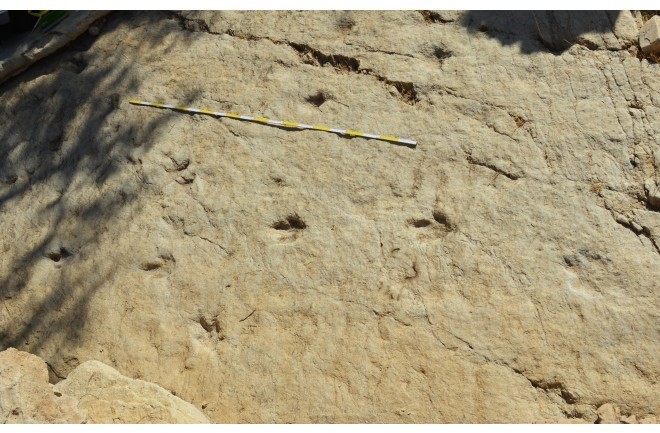AMMAN — Some 100 million years ago, dinosaurs roamed
the coast of the Tethys, an ancient ocean that covered most of the modern-day
Middle East. Recently, dozens of their footprints have been found on the
mountain of Safaha, in the south of Jordan, according to Discover magazine.
اضافة اعلان
In 2019, two Polish doctors stumbled across three-toed
footprints while hiking between Shobak and the ancient city of Petra. A few
months later, a team of German, Polish and Jordanian scientists surveyed the
site, on the arid mountain, to document the tracks.

“We found large trackways of several small to medium-sized
theropods, and also a few ornithopod footprints and one sauropod print,” says
Henrik Klein, an ichnologist and paleontologist at the Palaeontological Museum
in Germany.
He had participated in the expedition alongside Gerard
Gierliński, a paleontologist at the University of Warsaw, and Abdalla Abu Hamad,
a geology professor at the University of Jordan.
They discovered the prints in the marginal marine deposits
of the Na’ur Formation, which consists of well-bedded limestones, dolomites and
marls with abundant marine fossils. The three species identified — the
predatory theropod, the grazing ornithopod, and the long-necked, herbivorous
sauropod — indicate that the area had a flourishing ecosystem.
“It’s the first really diverse dinosaur footprint fauna in
the region,” says Klein. “The footprints we found are quite small, but they are
remarkably well preserved. It’s really excellent material, and it’s very rare
in the Middle East.”
An underexplored region
Even though dinosaur footsteps can be found in numerous
places around the world, very few have been documented in the Middle East —
since much of what is now land was then covered by the sea. The first dinosaur
footprint in the region was discovered in 1962 in
Jerusalem. In 2008, dinosaur
tracks from the Upper Jurassic were found in Yemen; more recently, a few
dinosaur footprints were spotted in Lebanon and Egypt.
In Jordan, most of the fossils found so far are of marine
invertebrates, such as bivalves, ammonites and foraminifers. But scientists say
there is a lot of potential for other fossil discoveries: “We need more studies
on dinosaur footprints in Jordan. I’m quite sure we will find more footprints
in the area, but we need more systematic exploration,” said Klein.
The scientists took 3D images of the trackways near Shobak,
though pandemic restrictions delayed travel plans to conduct more research in
2020 and 2021. Klein and his team published a preliminary study in Annales
Societatis Geologorum Poloniae in 2020, but he says further studies are needed.
“The footprints in Jordan are an amazing discovery,” says
Hesham Sallam, an Egyptian paleontologist who was not involved in the research.
In Jordan, there is still no paleontology department and no
institution protecting resources beyond human history — yet some Jordanians are
determined to raise awareness of the importance and value of local
paleontological resources.
Omar Fasheh, a Jordanian amateur paleontologist, came across
Klein’s study only recently, two years after its publication. To bring more
attention to it, he decided to look for the dinosaur tracks himself.
“I’m very passionate about fossils, so when I read about the
footprints, I wanted to see them,” says Fasheh.
“With my friend Mohammad Asfour, we visited the site and
tried to reach out to officials and institutions to see what could be done to
protect it.”
Scientists and enthusiasts hope the dinosaur footsteps will
continue to pave the way for more interest in paleontology in the region,
exposing more people to the field and building up local resources.
“The entire area is very important, so it should be turned
into a reserve,” says Asfour, a fossil enthusiast.
But for that to happen, the site must be protected from
damage and theft. Mining projects in nearby Dana, Jordan’s largest nature
reserve, for example, threaten the region’s natural and historical wealth.
“Most of the resources go to mineral exploration,” explains
Ikhlas Alhejoj, an associate professor of geology at the University of Jordan.
“There are a lot of people interested in the region’s gold, copper and
manganese. But the fossils we have are a real treasure (…) treasures that are
not just important for Jordanians, but for the entire world.”
Read more Features
Jordan News




